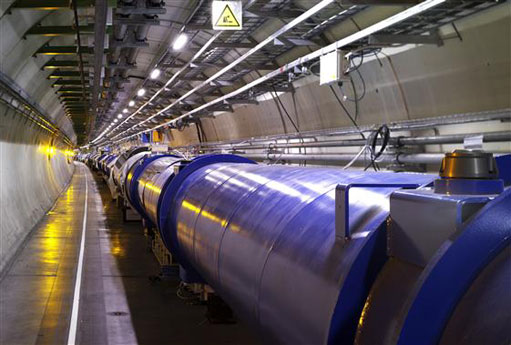
ATLAS e-News
23 February 2011
Prepare for beam
8 September 2008

The Large Hadron Collider is almost ready for its debut
On Wednesday, the world will be looking at CERN. Finally, the turn-on of the Large Hadron Collider will happen, and for the first time, a proton beam will circulate around the twenty-seven kilometres of the machine.
Right before beams will start crossing the LHC is the busiest time for the hardware commissioning team. They are in charge of getting key elements of the machine ready, such as the superconducting electromagnets.
The almost 1,700 superconducting electromagnets, with the magnetic field they generate, focus and bend the proton beams around the LHC. Their superconducting wire coils can carry large electric currents with virtually no resistance. Besides those main magnets, there are thousands of small orbit corrector magnets grouped in more than 1,500 electrical circuits.
Sandor Feher, from the hardware team, speaking in an interview on 3 September, said: “We are very close to the fully commission of this very large superconducting magnet system; all eight sectors are already cooled down to 1.9 K, and, at the moment, 95% of the magnets can carry their nominal current for, at least, an energy of five TeV, which in the case of the main dipole and quadrupole magnets can exceed 10 kilo Amperes.”
The beam commissioning team has also been successful in doing the synchronization tests of the beam. In the latest test, a single bunch of a few particles travelled down the transfer line from the Super Proton Synchrotron (SPS) accelerator to the LHC. After a period of optimization, one bunch was injected from the transfer line into the LHC beam pipe and circulated counter-clockwise about 3 kilometres around the LHC.
When asked about the big test on September 10th, Sandor is very confident on the performance of the machine: “Looking at the very high complexity of the system, we’ll all be very happy if we can circulate a beam all the way around the accelerator. That would be a major achievement within that day.”
“Then if things go very smoothly, we could try to circulate a beam in the other direction as well. But this is not expected; just one circulating beam – as it is planned – will be a great success for us.”
At the moment, the hardware commissioning team is working at full energy in these last days without beam inside the LHC. All members are running shifts of 8 hours, so that twenty-four hours a day, someone is on shift: “As this is the first time we are commissioning the system, we often have to go into the tunnel and replace faulty elements. After beam operation, we cannot get into the tunnel anymore, so we have to do it now,” Sandor explains.
One of the main issues that concern both the hardware and the beam commissioning teams is the safety operation of the machine. If a beam of protons was to escape its tube, it would create billions of particles and increase the temperature of any element it hits. The beams pass within about a centimetre of the superconducting magnets that have to be kept near absolute zero. So, if stray particles damage the magnets or other sensitive equipment, then the machine has to be switched off in order to repair the damage.
“We have to make sure that the operation is safe all the time – for the man, which is already guaranteed, and also for the machine,” Sandor explains.
When the Large Hadron Collider will be switched on Wednesday, the end of the construction of the most complex accelerator in the world will be partially finished: “It’s a very exciting moment, some people have been involved in the project for almost 20 years, so, for them, their most precious dream will come true on Wednesday,” Sandor says.
